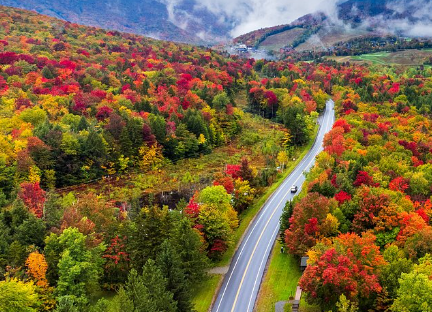Weather Effects on Fall Foliage
October 30, 2023
Early in the spring season, trees produce new sprouts from barren branches, and soon we see again the familiar lush green canopy that remains with us through the summer months. In the fall, something equally amazing takes place. These green leaves take on a wide array of colors, bright and vibrant, that signal a change of seasons. But what is behind this dramatic transformation?

Actually, many of these dazzling colors are present year-round in the leaves of deciduous trees. One such leaf pigment, chlorophyll, is produced by trees during the warmer and sunnier spring and summer months, giving leaves their characteristic green hue. However, as length of night increases, the production of chlorophyll gradually begins to decrease. This reduction in sunlight and cooler nights results in the revealing of carotenoids and anthocyanin. These pigments allow the leaves to show their true colors - reds, oranges, and yellows - that are so familiar during the fall season. Prime dew point temperatures for widespread frost formation are in the upper 20s to lower 30s. When this occurs with freezing air temperatures, everything is in place for potentially heavy frost formation. Frost formation is less likely with dew point temperatures below the mid 20s. There just isn't enough moisture in the air for significant frost formation, even if temperatures are below freezing. The length of time conditions are favorable for frost formation determines the intensity of frost. The more time the dew point and air temperature hover around or below 30 degrees, the heavier the frost.

The intensity and timing of fall colors is determined by two weather factors: temperature and rainfall. Plenty of warmth and sunshine during the day and crisp, cool nights tend to be the ideal conditions for producing the best colors. Adequate moisture during spring and summer also contributes to brilliant colors during the fall. But after the color change, how and why do leaves fall? As protection from the harsh winter conditions to come, trees produce a layer of cells at the base of each leaf. This closes off the veins that lead from the tree. With the flow of water and nutrients cut off, the leaf soon falls from the tree. The leaves have important work to do after falling off the tree. As they break down and mix with the soil below, leaves absorb rainfall that is used to water nearby plants and trees. This rich blend of nutrients helps maintain the health of the entire forest into the next spring season. The changing fall foliage is a reminder that there is a purpose to everything we see in nature. Each component is a vital activity for our survival and flourishing.
Contact AWIS | About Us